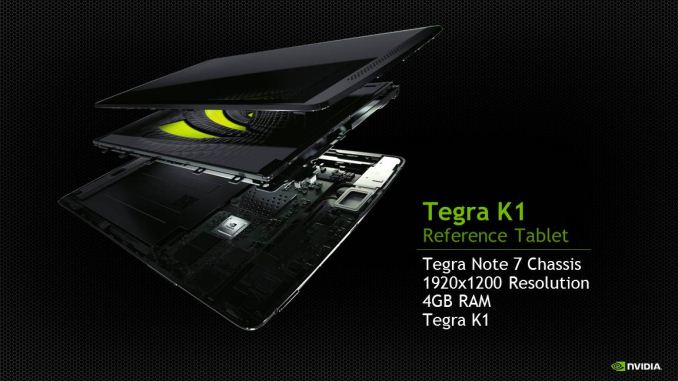NVIDIA Tegra K1 Preview & Architecture Analysis
by Brian Klug & Anand Lal Shimpi on January 6, 2014 6:31 AM ESTFinal Words
NVIDIA’s challenge with Tegra has always been getting design wins. In the past NVIDIA offered quirky alternatives to Qualcomm, most of the time at a more attractive price point. With Tegra K1, NVIDIA offers a substantial feature and performance advantage thanks to its mobile Kepler GPU. I still don’t anticipate broad adoption in the phone space. If NVIDIA sees even some traction among Android tablets that’s enough to get to the next phase, which is trying to get some previous generation console titles ported over to the platform.
NVIDIA finally has the hardware necessary to give me what I’ve wanted ever since SoC vendors first started focusing on improving GPU performance: the ability to run Xbox 360 class titles in mobile. With Tegra K1 the problem goes from being a user interface, hardware and business problem to mostly a business problem. Android support for game controllers is reasonable enough, and K1 more or less fixes the hardware limitations, leaving only the question of how do game developers make enough money to justify the effort of porting. I suspect if we’re talking about moving over a library of existing titles that have already been substantially monetized, there doesn’t need to be all that much convincing. NVIDIA claims it’s already engaged with many game developers on this front, but I do believe it’ll still be an uphill battle.
If I were in Microsoft’s shoes, I’d view Tegra K1 as an opportunity to revolutionize my mobile strategy. Give users the ability to run games like Grand Theft Auto V on a mobile device in the not too distant future and you’ve now made your devices more interesting to a large group of users. I don’t anticipate many wanting to struggle to play console games on a 5-inch touchscreen, but with a good controller dock (or tablet with a kickstand + wireless controller) the interface problem goes away.
For the first time I’m really excited about an NVIDIA SoC. It took the company five generations to get here, but we finally have an example of NVIDIA doing what it’s really good at (making high performance GPUs) in mobile. NVIDIA will surely update its Tegra Note 7 to a Tegra K1 version (most of its demos were run in a Tegra Note 7 chassis), but even if that and Shield are the best we get the impact on the rest of the market will be huge. With Tegra K1, NVIDIA really raised the bar on the GPU performance.
The CPU side, at least for the Cortex A15 version is less interesting to me. ARM’s Cortex A15, particularly at high clocks, has proven to be a decent fit for tablets. I am curious to see how the Denver version of Tegra K1 turns out. If the rumors are true, Denver could very well be one of the biggest risks we’ve seen taken in pursuit of building a low power mobile CPU. I am eager to see how this one plays out.

Finally: two big cores instead of a silly number of tiny cores
NVIDIA hasn’t had the best track record of meeting shipping goals on previous Tegra designs. I really hope we see Tegra K1, particularly the Denver version, ship on time (although I'm highly doubtful this will happen - new custom CPU core, GPU and process all at the same time?). I’m very eager not only for an install base of mobile devices with console-class GPUs to start building, but also to see what Denver can do. I suspect we’ll find out more at GTC about the latter. It’s things like Tegra K1 that really make covering the mobile space exciting.












88 Comments
View All Comments
easp - Wednesday, January 8, 2014 - link
So, it seems to me that 8 of these Denver cores would offer similar general purpose compute performance to a dual socket server from ~5-6 years ago, and yet, would make up a minuscule % of die area on a Tesla-class GPU die...Krysto - Saturday, January 11, 2014 - link
Some also say a Denver core should equal the Sandy Bridge core in performance, which would be quite impressive. That's what I have in my laptop, and it was a pretty high-end one 2 years ago.OreoCookie - Sunday, January 12, 2014 - link
Who wrote that, can you provide a link? I haven't seen any such claims. And I'm fairly sure nVidia would have mentioned that during the press event. Apple's A7 packs about the same punch as a Core 2 Duo, so it'd not be out of the question, but I'd be more cautious, especially seeing how high Intel's cpus turbo these days.PC Perv - Saturday, January 11, 2014 - link
How can you make so many definitive statements over what was essentially a PR pitch? It's too bad there is no "critics" or ombudsman to hold these bloggers accountable over time. (Granted that is also why these bloggers will never garner respects from mainstream media) These bloggers seemingly get away with anything they say as long as they keep their industry friends happy.If anyone wants to know what I am talking about, go back 2 ~ 3 years and check these clowns' articles. And check if they ever, i mean EVER, acknowledge their misjudgments or stupidity.
PC Perv - Saturday, January 11, 2014 - link
For instance, do you guys have any follow up on Tegra 4i?http://www.anandtech.com/show/6787/nvidia-tegra-4-...
Or ist it just the way it is with you guys? Just blow fanfare whenever OEM does a press conference, and completely forget about it in less than a year?
Have you no shame?
TheJian - Tuesday, January 14, 2014 - link
What fanfare? T4i is a Q1 product and the modem just got certified on ATT last month or so. The whole point of the T4i is the modem and phones so what is the problem? NV already showed it doing 150mbps (an update from 100mbps preview info) and this hasn't even been rolled out yet (anybody else running this besides Honk Kong/Singapore?). What do you want them to report? This product has been PULLED IN along with K1 at the cost of some T4 delay and sales. This is not news and everyone (even this NV hating site) has reported it :) T4i if late at all is only because of the modem awaiting which after checking happened Early Nov.Not sure this new modem speed is even interesting with caps we have today. At 50mbps on cable I can clock ~325GB or so pegged all day (that's north of 10TB/month). Even Hong Kong has a 10GB cap which is what, like 5x USA caps at 2GB usually? Even in HK that's only ONE 1080p flick and some browsing? I hope we start seeing Cell phone bill lawsuits soon that tie up these CAPPED companies so badly they are forced to stop this crap just due to litigation cost fears. But I think this is probably a pipe dream until google or someone else can offer unlimited mobile.
IE, google mentions rolling out Gbit internet in Austin, and ATT goes on immediate defense announcing huge speed upgrades (20x faster to 300mbps) and a future upgrade past that on the books not long after. So it is terribly expensive and not doable before google, but the same week google announces their roll-out, ATT can suddenly roll-out a huge upgrade and BEAT google's roll-out dates...LOL. But to match google's prices ($70) you have to OK them spying on you...ROFL. At least Google forced the updates.
http://www.theverge.com/2013/12/11/5200250/at-t-be...
Then claims they can deny google access to poles a few days later:
http://arstechnica.com/tech-policy/2013/12/why-att...
We can only hope the city votes on 23rd (next week) to allow low pole access pricing. Hard to say google would lose offering free internet to 100 libraries and public joints in the city that the CITY chooses, but they already delayed so maybe they're stupid or bribed heavily. :)
Maybe google just needs to announce everywhere and get ATT etc to announce matching $70 pricing then just say "just kidding". :) At worst they seem to easily force monopolies to respond as shown here. I hope they do the same in phones, amazon and apple too (heck MS also). We need all these big tech dogs to bark at cell providers big time and threaten their business models in any way they can. Competition from outsiders is sorely needed in cell or we'll be stuck with Verizon/ATT etc caps forever.
phoenix_rizzen - Thursday, January 16, 2014 - link
Rogers in Canada has 150 Mbps LTE using their 2600 MHz spectrum. It's been live for about a year now.They ran a speedtest competition around the time they lit up the first 2600 MHz towers in Ontario, and there were a *lot* of entries showing over 90 Mbps entries. It's listed somewhere on their Redboard blog.
My phone only does 100 Mbps LTE, and our town doesn't yet officially have LTE (there are 2 towers with it enabled out of the dozen or so towers in town), but I can get a consistent 40 Mbps on speedtests, with the occasional jump over 70.
So, if backward old Canada can get 150 Mbps LTE working, anywhere should be able to. :)
Oh, and 6 GB data plans are very common up here.
tipoo - Thursday, November 6, 2014 - link
I wonder if the code morphing has anything to do with the Nexus 9s performance inconsistency? Does amazing in most singular benchmarks, but when thrown multitasking or unpredictable code it chokes.